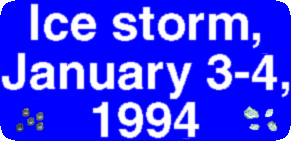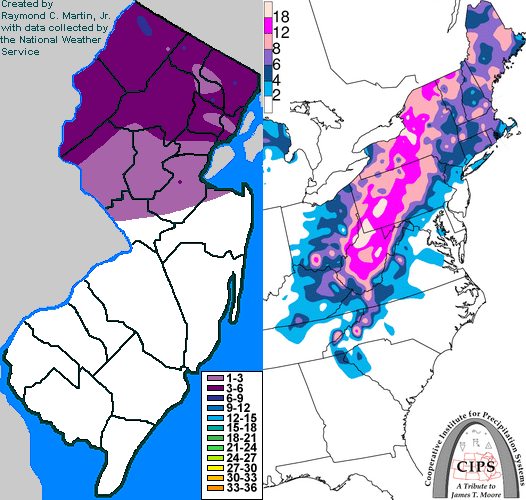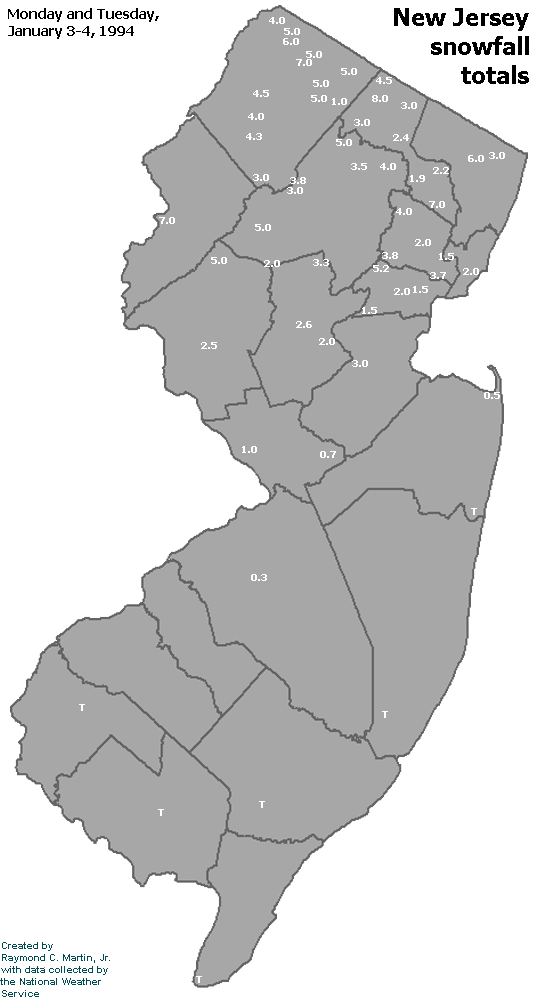

Storm description, surface observations, snowfall totals, and images courtesy of the National Climatic Data Center, the National Centers of Environmental Prediction, the Climate Prediction Center, the Hydrometeorological Prediction Center, the Mount Holly National Weather Service Office, the Upton National Weather Service Office, Rutgers University, Plymouth State University, the University of Illinois, the American Meteorological Society, Weather Graphics Technologies, AccuWeather, and the Weather Channel.
Table of Contents
Storm Summary
Regional Surface Observations
Satellite Imagery
Sea Level Pressure and 1000 to 500 Millibar Thickness Maps
850 Millibar Maps
700 Millibar Maps
500 Millibar Maps
300 Millibar Maps
200 Millibar Maps

Contoured Snowfall Totals from January 3-4, 1994
STORM DESCRIPTION
A powerful nor'easter moving up the Eastern Seaboard brought a mix of snow, ice and rain along with strong winds and coastal flooding to New Jersey.
Synoptic Discussion
During the day on January 2nd, a storm system dove southeastward across the Front Range of the Rockies, reaching southeastern Texas late in the day. As this storm moved eastward along the northwestern Gulf Coast early on January 3rd, a new storm system developed along the east coast of Florida. These two storms combined into one storm near Georgia on the evening of January 3rd, then moved northeastward up the Atlantic Coast while rapidly intensifying. The storm system reached Nova Scotia by the morning of January 5th.
Local Discussion
Precipitation overspread the state from southeast to northwest during the evening of January 3rd and continued through the midday hours of January 4th. Across southern New Jersey, precipitation was primarily in the form of rain due to warm air moving in off the ocean at low levels, though some sleet mixed with the rain at times. Across central New Jersey, an icy mixture of sleet and freezing rain preodominated as warm air moved in aloft, but cold air remained in place at the surface. In northern New Jersey, precipitation began in the form of snow late on January 3rd while the air was cold both at the ground and aloft, but transitioned to sleet and freezing rain during the early morning of January 4th in all areas except the far north as warmer air moved in aloft. Colder air wrapping back across the state behind the storm allowed the precipitation to brielfy change back to snow before ending. Total snow and ice accumulations across northern New Jersery generally ranged from 3 to 7 inches, while in central New Jersey accumulations ranged from a coating (where solely sleet and freezing rain fell) to 3 inches (where some snow fell as well). Only trace amounts were recorded across southern New Jersey. Significant wind damage, beach erosion and coastal flooding also occurred with this storm along the Jersey Shore.
New Jersey Snowfall Totals

Individual Snowfall Totals from January 3-4, 1994
Table of Contents
Storm Summary
Regional Surface Observations
Satellite Imagery
Sea Level Pressure and 1000 to 500 Millibar Thickness Maps
850 Millibar Maps
700 Millibar Maps
500 Millibar Maps
300 Millibar Maps
200 Millibar Maps
Snow storm, December 29-30, 1993
Ice storm, January 3-4, 1994
Ice storm, January 7-8, 1994
Snow and ice storm, January 17-18, 1994
Snow storm, January 25-26, 1994
Snow and ice storm, February 8-9, 1994
Snow and ice storm, February 11, 1994
Snow and ice storm, February 23-24, 1994
Snow and ice storm, March 2-3, 1994
Snow storm, March 18, 1994
Back to Ray's Winter Storm Archive
Copyright © 2012 by Raymond C Martin Jr. All rights reserved